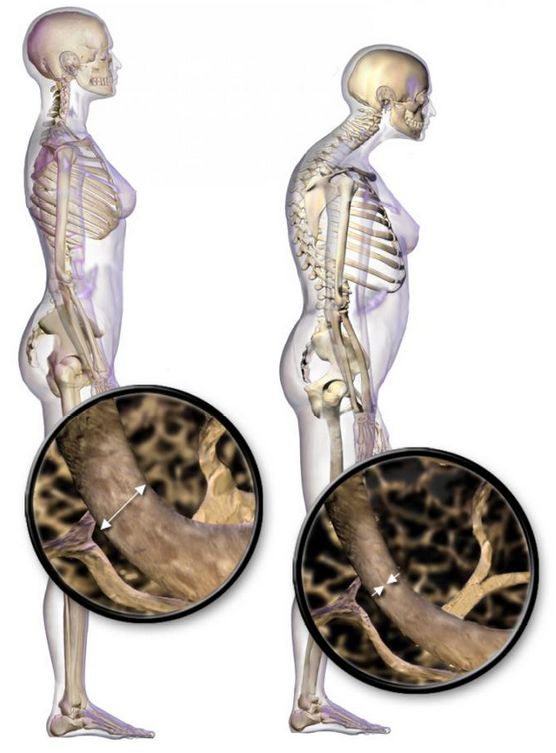| Osteoporose | meer botten, spieren, gewrichten |
|
|
 |
- osteoporose komt veel vaker voor bij vrouwen, maar sommige mannen krijgen ook osteoporose
- meestal wordt osteoporose veroorzaakt door veroudering, een laag gehalte aan geslachtshormonen, en te weinig vitamine D of calcium
- u kunt osteoporose voorkomen door voldoende calcium en vitamine D binnen te krijgen, gewichtdragende oefeningen te doen (zoals wandelen of gewichtheffen) en bepaalde medicijnen te nemen
Botten die eerder breken bij osteoporose zijn onder andere:
- pols
- ruggengraat (wervels)
- heup
Een breuk in een van de wervelbeenderen in uw midden- of onderrug kan ertoe leiden dat de beenderen gedeeltelijk inzakken. Dit wordt een wervelcompressiefractuur genoemd.
Oorzaak
Osteoporose wordt meestal veroorzaakt door:
- veroudering
- bij vrouwen een laag oestrogeengehalte (vrouwelijk geslachtshormoon) - dit komt voor na de menopauze
- bij mannen, een laag testosterongehalte (het geslachtshormoon van mannen)
- niet genoeg vitamine D of calcium krijgen
Wie loopt een verhoogd risico op osteoporose?
U heeft een verhoogd risico op osteoporose als u:
- erg mager bent
- langdurig in bed ligt zonder te bewegen
- rookt of alcohol drinkt
- familieleden heeft met osteoporose
Symptomen
- in het begin veroorzaakt osteoporose geen symptomen. Als uw botten niet breken, heeft u misschien nooit klachten
- wanneer uw botten door osteoporose breken, heeft u meestal pijn. Soms echter, wanneer uw wervelkolom botten instort, heeft u in het begin geen pijn. Later kunt u dan rugpijn krijgen die erger wordt als u staat of loopt
- als meerdere wervelkolombotten achter elkaar in elkaar zakken, kan uw wervelkolom krom gaan staan en kunt u korter worden
Diagnose
- artsen vermoeden dat u osteoporose heeft als u een vrouw bent die ouder is dan 65 jaar of risicofactoren voor osteoporose heeft
- artsen zullen testen hoe dicht uw botten zijn met behulp van een speciaal type röntgenfoto, een DXA / DEXA scan
- Dual-Energy X-ray-absorptionmetrie, een methode om de botdichtheid te meten waarbij met lage dosis röntgenstraling het bot op twee plaatsen (wervelkolom en heup) wordt onderzocht; om onderscheid te kunnen maken tussen weke delen en gezonde delen bot wordt gammastraling gebruikt met twee verschillende energiepieken (dual energy).
Uw arts zal meestal een DXA-scan maken als u:
- een vrouw ouder dan 65 jaar
- een vrouw na de menopauze die jonger is dan 65 en risicofactoren heeft
Soms zal uw arts bloedonderzoek doen om uw vitamine D- en calciumgehalte te controleren.
Behandeling
Als u een botbreuk hebt die door osteoporose wordt veroorzaakt, kan uw arts
- een gipsverband aanleggen
- opereren
- u een rugbrace laten dragen (voor een ingezakt bot in uw rug) en fysiotherapie doen
Artsen zullen uw osteoporose ook behandelen om te voorkomen dat uw botten zwakker worden door u:
- voedingsmiddelen te eten met grotere hoeveelheden calcium en vitamine D
- gewichtdragende oefeningen te doen, zoals wandelen en traplopen
- medicijnen zoals bisfosfonaten neemt; bisfosfonaten kunnen helpen uw botdichtheid op te bouwen. Hormoonsupplementen zijn ook goed voor de botten. Een laag gehalte aan vrouwelijke hormonen kan namelijk het risico op botontkalking verhogen. Artsen schrijven gewoonlijk echter geen hormoonsupplementen voor alleen voor osteoporose
Preventie
Het voorkomen van osteoporose werkt beter dan het behandelen ervan. U kunt osteoporose helpen voorkomen als u:
- stopt met roken of niet begint met roken
- alcohol beperkt
- de door uw arts voorgeschreven hoeveelheden calcium en vitamine D binnenkrijgt, die u uit vitamines of voedingsmiddelen kunt halen
- gewichtdragende oefeningen doet, zoals wandelen en traplopen
- de medicijnen neemt die u van uw arts moet innemen
Bronnen:
- Merck Manual, professional version
- Merck Manual, consumer version
- Beers, Marc H. (red.), 2005, 2e druk. Merck Manual Medisch Handboek. Bohn Stafleu van Loghum. 1970 blz. ISBN 978-90-313-4300-5. blz.341-345
- Beers, Marc H. (red.), 2008, 1e druk. Merck Manual Leeftijd & Gezondheid. Over gezond ouder worden. Bohn Stafleu van Loghum. 926 blz. ISBN 978-90-313-4758-2. blz.240-253
- Wiki
- Osteoporosevereniging.nl
Medicatie
Bisfosfonaten zoals alendroninezuur (Fosamax), clodroninezuur, etidroninezuur/calciumcarbonaat, pamidroninezuur, tiludroninezuur, risedroninezuur (Actonel), zoledroninezuur.
- Bouvy, M. & Buurma, H. 2012. Het juiste medicijn. Consumentenbond. ISBN 978-90-5951-192-7, pagina 184-186
- Wolffers, Ivan. 2005. Medicijnen 2006-2007. Klachten, ziekten, behandeling en medicatie. 1028 blz. Uitg.Contact. ISBN 978-90-254-2604-2, pagina 179-180
| Laatste wijziging: 5 januari 2022 | Colofon Disclaimer Privacy Zoeken Copyright © 2002- G. Speek |